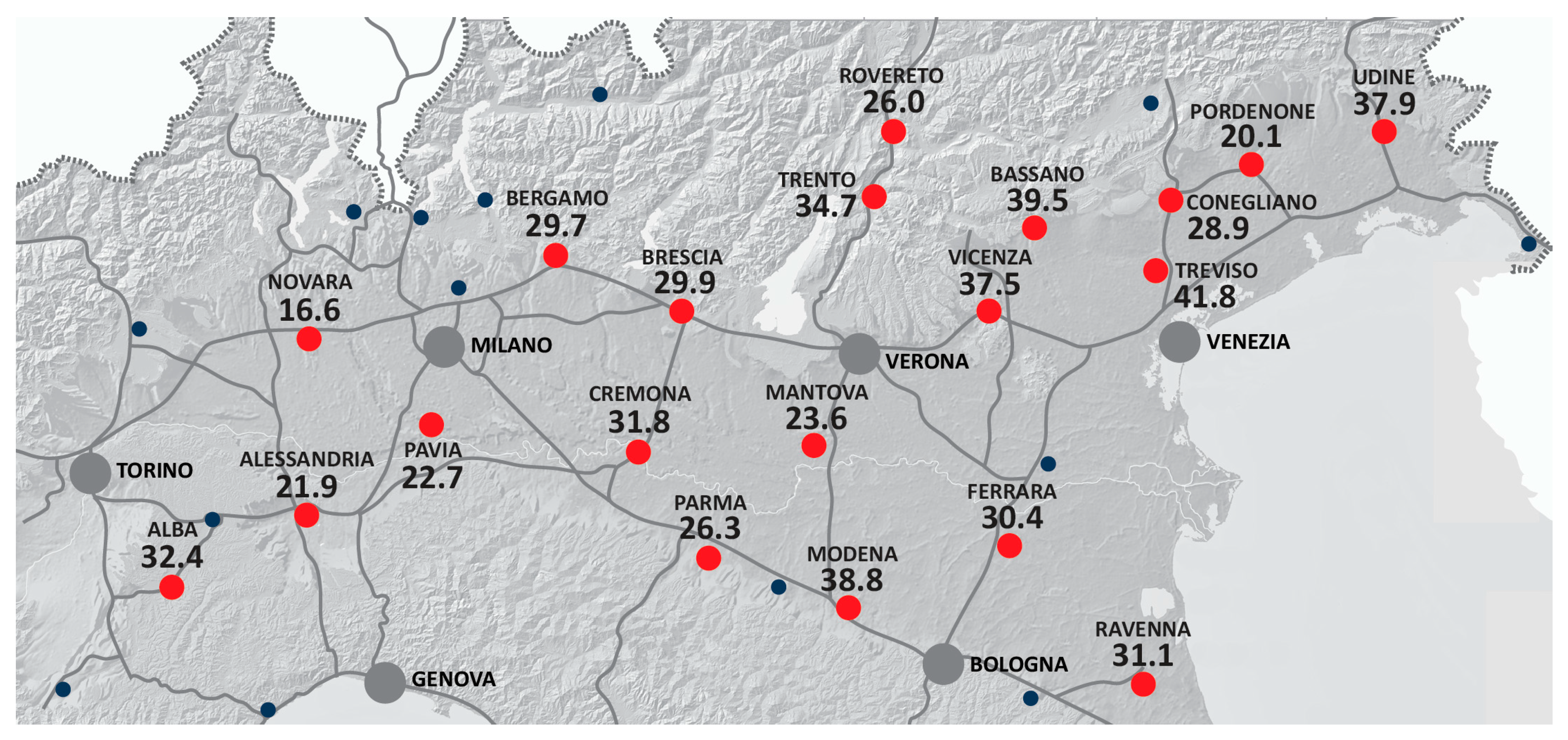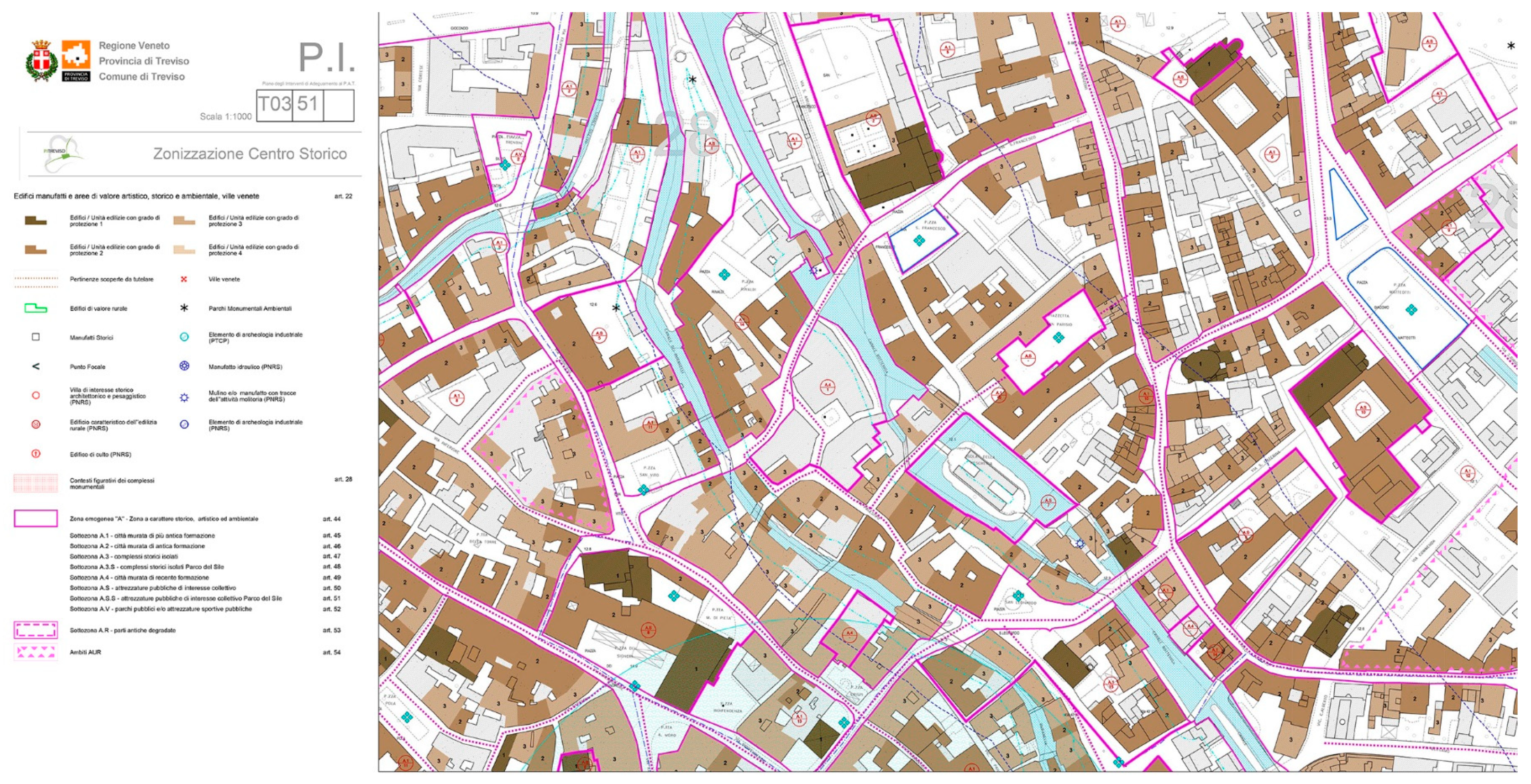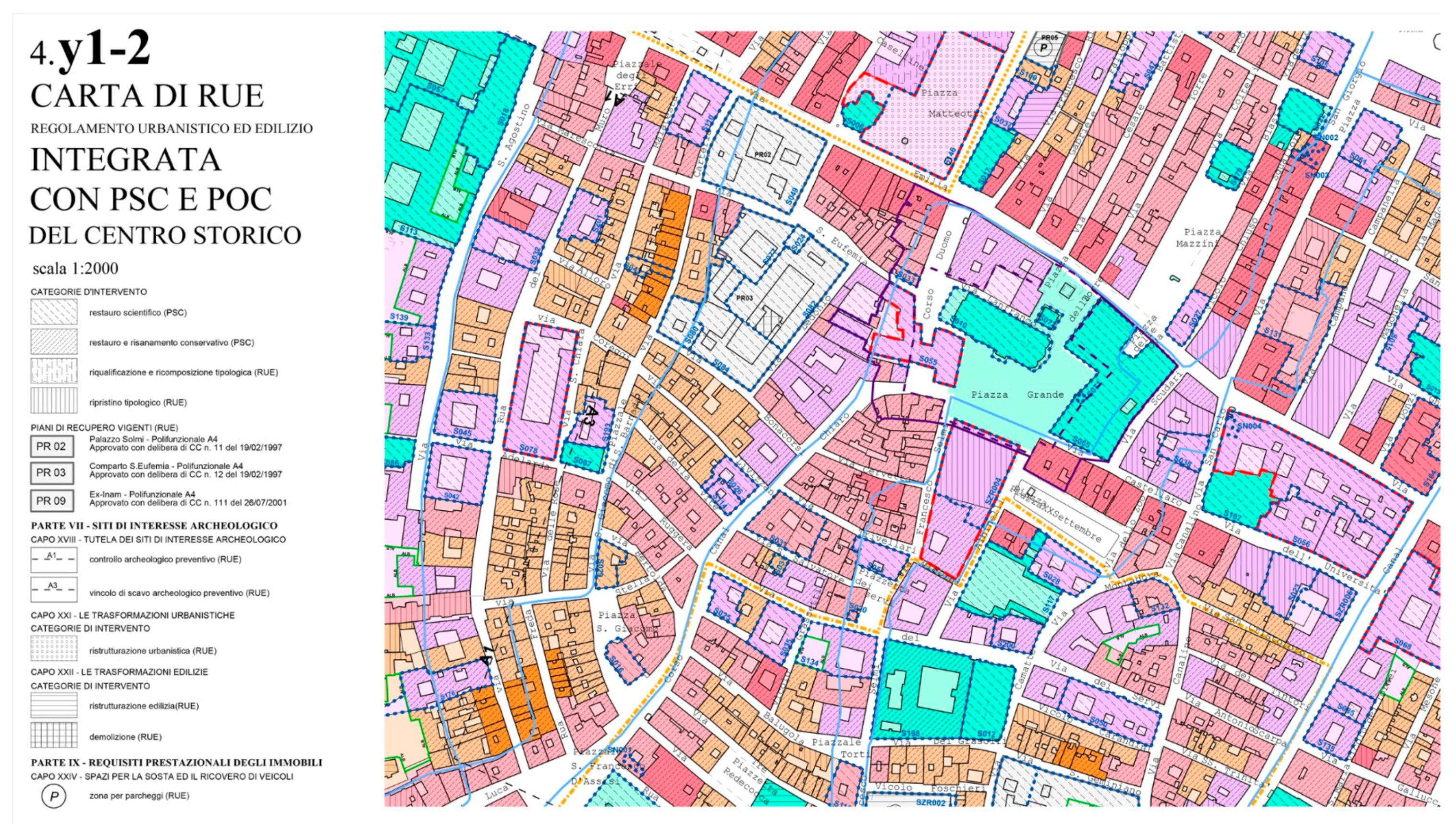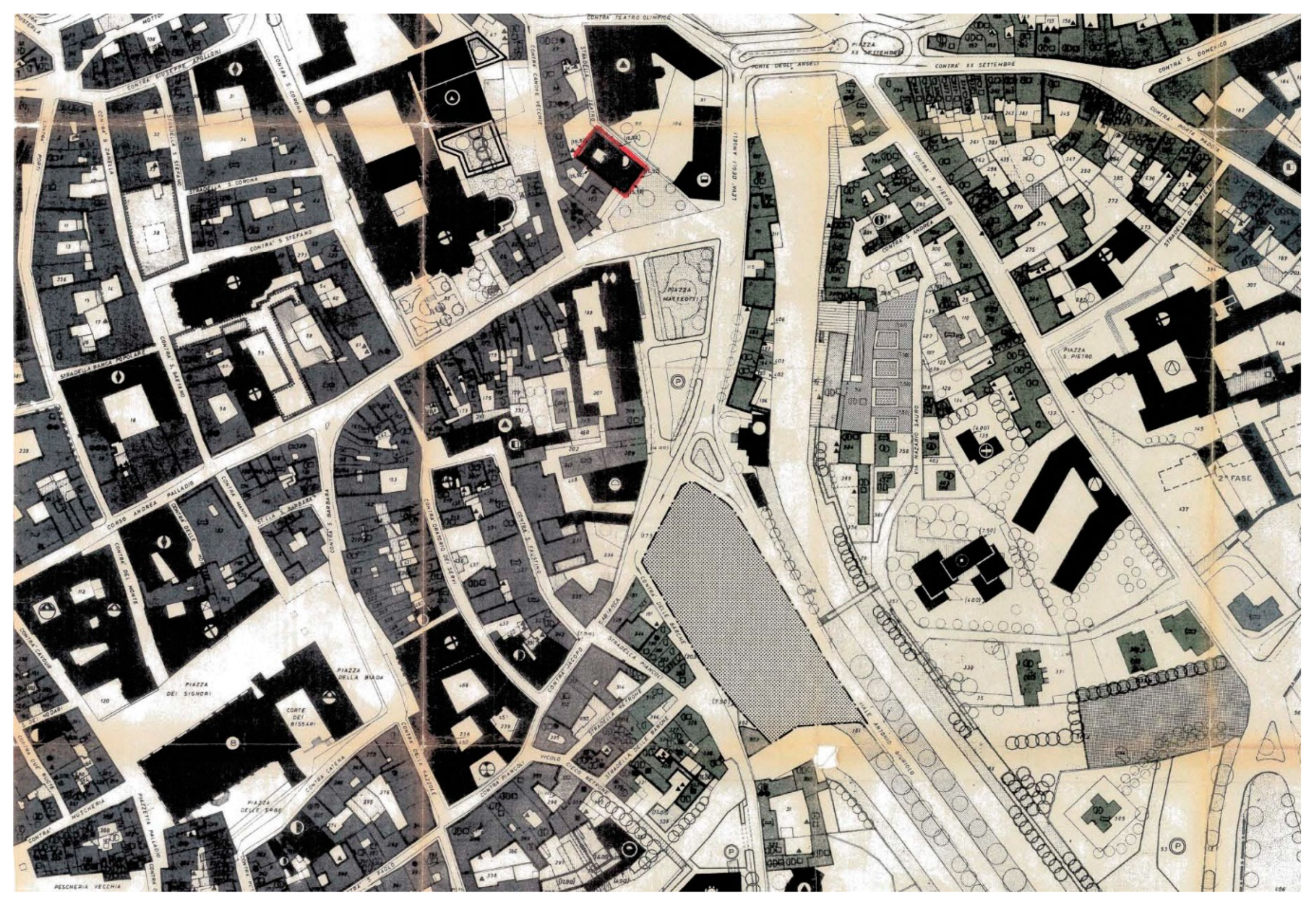Paradoxes of the Italian Historic Centres between Underutilisation and Planning Policies for Sustainability
Abstract
:1. Introduction and Research Method
- We increased the number of cities we investigated to 20 in order to cover the whole of Northern Italy; the same phenomena found in the first 14 cases were found also in the six new ones.
- Selection of the cities to further analyze according to the findings: The cities with the worst condition of vacancy were selected because the phenomenon in these cities is so evident that local planning activity should have tried to deal with the issue; the paper claims the city plans are not the main factor which caused the vacancy, but a mix of socio-economic causes. Therefore, the paper explores how planning activity reacts to the phenomenon where it is most observable.
- Collection of the city plans available in the official web page of the municipalities: The general planning documents and those specifically related to heritage conservation (if any) were collected.
- Analysis of the texts and maps of the plans, both in the descriptive parts (focusing on which phenomena are impacting the city according to the documents and if underutilisation is recorded among them) and in the design part (focusing on what development is proposed, what importance is given to sustainability, which actions are defined for the city centre and what role it is given in the future of the city). The selected cities are in different regions, and every region in Italy has a city planning law. Therefore, the planning processes are slightly different and the documents cannot be directly compared.
- Assessment of the conceptual and practical link between the phenomena of underutilisation and the choices of the plans for sustainability, that is to say if and how the “empty” built heritage in historic city centres is given a role to support the sustainable development of cities in the perspective of a circular economy and according to the International Charters and debate about urban development, which widely promote the connection of built urban heritage and sustainability [17,18,19].
- Conclusions, both expressed as paradoxes and challenges.
2. Evidence of Underutilisation of the Built Stock in Historic Centres of Small-to-Medium-Sized Cities in Northern Italy
3. The Missed Opportunity of Promoting the Re-cycling of the City Centres in the City Planning Instruments
- if the underutilization is reported;
- if sustainability is among the goals of the city;
- if the built heritage in the centre is considered an asset to exploit and reduce the consumption of land, establishing in this way a direct link between the phenomena and an efficient and sustainable use of resources;
- if innovative rules are established to both facilitate the regeneration process and conserve the heritage;
- if new developments and land consumption are planned.
3.1. City of Treviso, Acknowledgement of the Phenomenon in the Bigger Picture but Late and Limited Action
3.2. City of Udine, neither Acknowledgement nor Action
3.3. City of Modena, Early Acknowledgement of the Phenomenon and Recent Attempt to Promote Actions
3.4. City of Vicenza, Some Acknowledgement and Some Action Limited in Purpose
3.5. Structural Difficulties and Conservational Approach
4. Four Paradoxes of the Italian Historic City Centres
4.1. High-density and Compactness
4.2. Community Life and Local Identity
4.3. Recurrent Re-generation and Accumulation of Resources or Embedded Energy
4.4. Vanished Appeal
5. Conclusion: A Renewed Cultural and Economic Approach to Recycle the Wasted Urban Heritage for a Sustainable Development
- survey in depth the phenomenon of abandonment and acknowledge its impact; consider the built stock in the historic centre as an essential asset to balance expansion and re-functionalize the built heritage resources;
- re-define what changes of the heritage can be allowed without diminishing its value; in doing so, the plan must consider if the dense regulatory mechanism, matured over the course of decades of economic and demographic growth, is an obstacle for innovative practices and what elements in the policies prevent revitalization;
- find a balance between “original” residents and the significant presence of foreign people;
- contrast mono-functionality connected to the development of specific services, tourism in particular, in order to rely not only on one source of revenues and maintain residents and vitality.
Author Contributions
Funding
Conflicts of Interest
References
- ANCSA Associazione nazionale centri storici artistici. Salvaguardia e risanamento dei centri storico-artistici, Atti del convegno nazionale per la Salvaguardia e il Risanamento dei Centri Storici; ANCSA: Gubbio, Italy, 1960. [Google Scholar]
- Tafuri, M. Il problema dei centri storici nella nuova dimensione urbana. In La città territorio, un esperimento didattico sul centro direzionale di Centocelle in Roma; AAVV; Leonardo da Vinci: Roma, Italy, 1964; pp. 38–40. [Google Scholar]
- Carozzi, C.; Rozzi, R. Centri storici, questione aperta: il caso delle Marche; De Donato: Bari, Italy, 1971. [Google Scholar]
- AAVV. L’intervento pubblico nei centri storici, problemi sociali, giuridici, economici, architettonici e tecnici; Edizioni di Edilizia Popolare: Roma, Italy, 1973. [Google Scholar]
- Vassallo, E. Centri antichi 1861–1974: note sull’evoluzione del dibattito. Restauro 1975, 19, 3–96. [Google Scholar]
- Ceccarelli, P.; Indovina, F. Risanamento e speculazione nei centri storici; Angeli: Milano, Italy, 1977. [Google Scholar]
- Ciardini, F.; Falini, P. L’analisi dei centri storici, manuale per la formazione degli strumenti di intervento urbanistico; Officina: Roma, Italy, 1981. [Google Scholar]
- Per una storia del restauro urbano: Piani, strumenti e progetti per i centri storici; Giambruno, M. (Ed.) Cittastudi: Torino, Italy, 2007. [Google Scholar]
- La scoperta della città antica. Esperienza e conoscenza del centro storico nell’Europa del Novecento; Cutolo, D.; Pace, S. (Eds.) Quodlibet Studio: Macerata, Italy, 2016. [Google Scholar]
- ANCSA Associazione nazionale centri storici artistici; Cresme. Centri storici e futuro del Paese. Indagine nazionale sulla situazione dei centri storici; Documenti ANCSA: Roma, Italy, 2017. [Google Scholar]
- Balletti, F.; Ghersi, A. Abitare il centro storico: studi documenti e progetti per il cuore della città di Genova; Alinea: Firenze, Italy, 2014. [Google Scholar]
- Marcoaldi, P. Per la città di Viterbo: Masterplan del centro storico; Quodlibet: Macerata, Italy, 2018. [Google Scholar]
- Bellia, P.; Puma, P. Firenze, la trasformazione del centro antico; Edifir: Firenze, Italy, 2018. [Google Scholar]
- Ferrigni, F.; Sorrentino, M.C. Il futuro dei territori antichi: problemi, prospettive e questioni di governance dei paesaggi culturali evolutivi viventi; Edipuglia: Bari, Italy, 2013. [Google Scholar]
- Micelli, E.; Pellegrini, P. Wasting heritage. The slow abandonment of the Italian Historic Centres. J. Cult. Herit. 2018, 31, 180–188. [Google Scholar] [CrossRef]
- Micelli, E.; Pellegrini, P. Vuoto al centro. Impiego ed abbandono del patrimonio dei centri antichi italiani. Territorio 2017, 82, 157–170. [Google Scholar] [CrossRef]
- Habitat-III. Third United Nations Conference on Housing and Sustainable Urban Development; New Urban Agenda, UN: Quito, Ecuador, 2016. [Google Scholar]
- United Nations. Transforming our World: The 2030 Agenda for Sustainable Development; UN: New York, NY, USA, 2015. [Google Scholar]
- Labadi, S.; Logan, W. Urban Heritage, Development and Sustainability; Routledge: Oxford, UK, 2016. [Google Scholar]
- Klusáková, L. Small Towns in Europe in the 20th and 21st Centuries: Heritage and Development Strategies; Karolinum Press: Prague, Czech Republic, 2018. [Google Scholar]
- Management of Historic Centres; (Conservation of the European Built Heritage Series Book 2); Pickard, R. (Ed.) Taylor & Francis, e-book: Oxfordshire, UK, 2013. [Google Scholar]
- Free Market, the Irish Pavilion at the 16th International Architecture Exhibition Freespace 2018. Available online: http://free-market.ie/ (accessed on 10 July 2018).
- Ministère de la Cohésion des territoires et des Relations avec les collectivités territoriales. Action Coeur de Ville. Available online: https://www.cget.gouv.fr/sites/cget.gouv.fr/files/atoms/files/plaquette_actioncoeurdeville.pdf (accessed on 10 March 2019).
- Nilsson, L. Can small towns survive in a global World? In Proceedings of the International Conference EAUH 2018 Urban Renewal and Resilience, Cities in Comparative Perspective, Rome, Italy, 28 August–1 September 2018. [Google Scholar]
- Statistiche ISTAT. Censimento Popolazione Abitazioni. Available online: http://dati-censimentopopolazione.istat.it/Index.aspx (accessed on 10 May 2018).
- Statistiche ISTAT. Censimento Industria e servizi. Available online: https://www.istat.it/it/censimenti-permanenti/censimenti-precedenti/industria-e-servizi (accessed on 10 May 2018).
- ISTAT—Istituto nazionale di statistica. Forme, Livelli e Dinamiche Dell’urbanizzazione In Italia; ISTAT: Roma, Italy, 2017. [Google Scholar]
- Comune di Treviso. Piano di Assetto del Territorio Comunale (P.A.T.). Available online: http://www.comune.treviso.it/pat/ (accessed on 10 September 2018).
- Comune di Treviso. Piano degli Interventi (P.I.). Available online: https://www.comune.treviso.it/rigenerazione-urbana-riqualificazione-quartieri-4/urbanistica/piano-degli-interventi-p-i/ (accessed on 10 September 2018).
- Comune di Treviso. PAT, R03, Verifica del Dimensionamento; Comune di Treviso: Treviso, Italy, 2015. [Google Scholar]
- Comune di Treviso. PAT, R01, Relazione tecnica; Comune di Treviso: Treviso, Italy, 2015. [Google Scholar]
- Comune di Treviso. PI, R01, Relazione tecnica illustrative; Comune di Treviso: Treviso, Italy, 2018. [Google Scholar]
- Comune di Treviso. PI, R02, Verifica del Dimensionamento; Comune di Treviso: Treviso, Italy, 2018. [Google Scholar]
- Comune di Udine. Piano Regolatore Comunale Generale. Available online: http://www.comune.udine.gov.it/aree-tematiche/edilizia-territorio/urbanistica/piano-regolatore-generale-comunale (accessed on 15 September 2018).
- Comune di Udine. PRGC, Relazione Generale; Comune di Udine: Udine, Italy, 2012.
- Comune di Udine. PRGC, Relazione sul dimensionamento; Comune di Udine: Udine, Italy, 2012.
- Comune di Modena. PRG—Piano Regolatore Generale. Available online: http://urbanistica.comune.modena.it/ (accessed on 18 September 2018).
- Comune di Modena. Rapporto sul centro storico. Available online: http://urbanistica.comune.modena.it/index_Centro.html (accessed on 18 September 2018).
- Comune di Modena. PRG 2003, Testo coordinato delle norme di PSC—POC—RUE; Comune di Modena: Modena, Italy, 2015. [Google Scholar]
- Comune di Modena. PRG 2003, Carta di PSC del Centro Storico, 2.t1, Variante al POC-RUE approvata con delibera di C.C. n° 48 del 07/05/2015; Comune di Modena: Modena, Italy, 2015. [Google Scholar]
- Comune di Vicenza. Piano regolatore comunale (Pat-Pi) e piani urbanistici (Pua). Available online: https://www.comune.vicenza.it/servizi/prg.php (accessed on 20 September 2018).
- Comune di Vicenza. PAT Relazione Tecnica; Comune di Vicenza: Vicenza, Italy, 2010. [Google Scholar]
- Comune di Vicenza. Relazione al piano particolareggiato di esecuzione del centro storico; Comune di Vicenza: Vicenza, Italy, 1969. [Google Scholar]
- Comune di Vicenza. PI, Relazione Programmatica; Comune di Vicenza: Vicenza, Italy, 2013. [Google Scholar]
- Pellegrini, P.; Micelli, E. Wasted heritage. Between policies for urban heritage and land consumption. In Proceedings of the 6th International Conference on Heritage and Sustainable Development HERITAGE 2018, Granada, Spain, 15 June 2018. [Google Scholar]
- Cristinelli, G. Saverio Muratori e Egle Renata Trincanato. La nascita del restauro urbano in Italia; Ginevra Bentivoglio EditoriA: Roma, Italy, 2013. [Google Scholar]
- Il progetto del passato; Pedretti, B. (Ed.) Bruno Mondadori: Milano, Italy, 1997. [Google Scholar]
- Koolhaas, R. Preservation Is Overtaking Us; Carver, J., Ed.; Columbia Books on Architecture and the City, GSAPP Transcripts: New York, NY, USA, 2014. [Google Scholar]
- Romano, M. La città come opera d’arte; Einaudi: Milano, Italy, 2008. [Google Scholar]
- Ferlenga, A.; Vassallo, E. Antico e Nuovo. Architetture ed Architettura; Il Poligrafo: Venezia, Italy, 2008. [Google Scholar]
- Cervellati, P. L’arte di curare la città; Il Mulino: Bologna, Italy, 2000. [Google Scholar]
- Rogers, R. Cities for a Small Planet; Basic Books: London, UK, 1998. [Google Scholar]
- Glaeser, E. Triumph of the City; Penguin Random House: New York, NY, USA, 2011. [Google Scholar]
- Owen, D. Green Metropolis. Why Living Smaller, Living Closer, and Driving Less Are the Keys to Sustainability; Riverhead Books: New York, NY, USA, 2009. [Google Scholar]
- Ng, E. Designing High-Density Cities: For Social and Environmental Sustainability; Earthscan Ltd.: London, UK, 2010. [Google Scholar]
- Barattucci, C. La riqualificazione sostenibile dei centri storici come risposta italiana alla moltiplicazione degli ecoquartieri europei. Presented at the XXI Conferenza Nazionale Societa’ Italiana degli Urbanisti, Firenze, Italy, 5 June 2018. [Google Scholar]
- Sitte, C. The Art of Building Cities: City Building According to Its Artistic Fundamentals; Martino Fine Books: Eastford, CT, USA, 2013. [Google Scholar]
- Whyte, W. The Social Life of Small Urban Spaces; Project for Public Spaces: New York, NY, USA, 1980. [Google Scholar]
- Gehl, J. Life between Buildings: Using Public Space; Island Press: Washington, DC, USA, 1987. [Google Scholar]
- Congress for the New Urbanism. Charter of the New Urbanism; McGraw-Hill Professional: San Francisco, CA, USA, 1999. [Google Scholar]
- Rossi, A. L’architettura della città; Marsilio: Padova, Italy, 1966. [Google Scholar]
- De Carlo, G. Urbino: la storia di una città e il piano della sua evoluzione urbanistica; Marsilio: Padova, Italy, 1966. [Google Scholar]
- Re-cycle Italy. Available online: http://www.recycleitaly.net (accessed on 5 June 2018).
- Ellen Macarthur Foundation. Available online: ellenmacarthurfoundation.org (accessed on 5 June 2018).
- Indovina, F. La città diffusa. In La città diffusa; Indovina, F., Matassoni, F., Savino, M., Sernini, M., Torres, M., Vettoretto, L., Eds.; Daest-IUAV: Venezia, Italy, 1990; pp. 21–43. [Google Scholar]
- Bandarin, F.; van Oers, R. Il paesaggio urbano storico: La gestione del patrimonio in un secolo urbano; CEDAM: Padova, Italy, 2014; pp. 32–33. [Google Scholar]
- Operationalising the Historic Landscape, a Practitioner’s View; Zhou, J.; van Oers, R. (Eds.) Tongji University Press: Shanghai, China, 2018. [Google Scholar]
- Forte, F. Historic, Artistic and Cultural Patrimony for a “Habitable City”: Incentives for Care. In Integrated Evaluation for the Management of Contemporary Cities, SIEV 2016; Mondini, G., Fattinnanzi, E., Oppio, A., Bottero, M., Stanghellini, S., Eds.; Springer: Cham, Switzerland, 2018; pp. 233–243. [Google Scholar] [CrossRef]
- Pickerill, T.; Pickard, R. A Review of Fiscal Measures to Benefit Heritage Conservation; RICS Research Paper Series; Dublin Institute of Technology: Dublin, Ireland, 2007; Volume 7, p. 6. [Google Scholar]




| City | Region | Population Outside the Center, 2011 | Population Variation 1991–2011 Outside the Center (%) | Population Variation 1991–2011 in the ZTL (%) | Population Variation 1991–2011 in the Historic Center (%) | Unoccupied Units Outside the Center, 2011 (%) | Unoccupied Units Outside the Center, 1991 (%) | Unoccupied Units in the ZTL, 2011 (%) | Unoccupied Units in the ZTL, 1991 (%) | Unoccupied Units in the Historic Center, 2011 | Difference 2011–1991 of Unoccupied Units Outside the Center (%) | Difference 2011–1991 of Unoccupied Units in the ZTL (%) | Foreigners in the Center on the Total Residents (%) |
|---|---|---|---|---|---|---|---|---|---|---|---|---|---|
| Udine | Friuli Venezia Giulia | 98,287 | 1.06 | −8.30 | −10.23 | 12.5 | 7.45 | 37.9 | 15.69 | 2127 | 5.05 | 22.21 | 16.42 |
| Pordenone | Friuli Venezia Giulia | 50,542 | 0.79 | −3.87 | −3.87 | 13.1 | 8.22 | 20.1 | 22.66 | 115 | 4.88 | −2.56 | 9.61 |
| Treviso | Veneto | 81,014 | −2.16 | −5.41 | −11.67 | 12.39 | 6.64 | 41.78 | 21.39 | 1344 | 5.75 | 20.39 | 8.48 |
| Conegliano | Veneto | 34,428 | −3.18 | −0.71 | −2.92 | 15.33 | 8.79 | 28.87 | 20.17 | 203 | 6.54 | 8.7 | 13.09 |
| Vicenza | Veneto | 111,500 | 4.76 | −2.11 | −4.57 | 15.27 | 7.51 | 37.46 | 23.17 | 2097 | 7.76 | 14.29 | 12.36 |
| Bassano dG | Veneto | 43,011 | 4.98 | −2.22 | −2.22 | 18.15 | 9.47 | 39.5 | 17.38 | 743 | 8.68 | 22.12 | 10.25 |
| Mantova | Lombardia | 46,649 | −12.36 | −11.29 | −11.58 | 12.05 | 4.69 | 23.58 | 13.7 | 2138 | 7.36 | 9.88 | 8.22 |
| Brescia | Lombardia | 189,931 | −2.68 | 3.25 | 1.54 | 13.08 | 6.28 | 29.93 | 22.47 | 3013 | 6.8 | 7.46 | 24.41 |
| Cremona | Lombardia | 69,589 | −2.87 | −11.02 | −13.66 | 15.85 | 5.82 | 31.82 | 11.8 | 3808 | 10.03 | 20.02 | 18.06 |
| Bergamo | Lombardia | 115,349 | 0.76 | −21.27 | −21.27 | 13.07 | 9.63 | 29.68 | 20.78 | 463 | 3.44 | 8.9 | 4.19 |
| Pavia | Lombardia | 68,280 | −10.54 | −11.79 | −14.57 | 8.52 | 10.35 | 22.69 | 25.14 | 1390 | −1.83 | −2.45 | 6.88 |
| Trento | Trentino Alto Adige | 114,198 | 12.41 | 14.54 | 14.01 | 14.35 | 9.97 | 34.68 | 22.92 | 957 | 4.38 | 11.76 | 10.59 |
| Rovereto | Trentino Alto Adige | 37,754 | 15.32 | 2.96 | 8.44 | 14.57 | 11.27 | 25.96 | 20.39 | 545 | 3.3 | 5.57 | 19.61 |
| Ferrara | Emilia Romagna | 132,545 | 0.98 | −17.84 | −21.59 | 14.3 | 6.6 | 30.4 | 18.08 | 4560 | 7.7 | 12.32 | 8.55 |
| Modena | Emilia Romagna | 179,149 | 1.31 | 0.98 | −0.22 | 16.22 | 8.89 | 38.81 | 23.28 | 3238 | 7.33 | 15.53 | 26.14 |
| Ravenna | Emilia Romagna | 153,740 | 14.23 | 3.15 | −4.48 | 28.51 | 29.06 | 31.14 | 9.49 | 1297 | −0.55 | 21.65 | 12.19 |
| Parma | Emilia Romagna | 175,895 | 5.35 | −9.17 | −11.02 | 12.69 | 7.82 | 26.33 | 17.55 | 3774 | 4.87 | 8.78 | 15.88 |
| Alba | Piemonte | 30,804 | 6.13 | −5.64 | −5.17 | 13.9 | 7.12 | 32.38 | 14.86 | 481 | 6.78 | 17.52 | 12.98 |
| Novara | Piemonte | 101,952 | 0.65 | 9.19 | 6.23 | 7.23 | 7.45 | 15.58 | 26.72 | 258 | −0.22 | −11.14 | 12.36 |
| Alessandria | Piemonte | 89,411 | 0.52 | −13.64 | −10.25 | 13.13 | 7.19 | 21.87 | 8.71 | 1224 | 5.94 | 13.16 | 17.75 |
| Average | 1.77 | −4.51 | −5.95 | 14.21 | 9.01 | 30.02 | 18.82 | 5.20 | 11.21 | 13.40 | |||
| Total | 1,924,028 | 33,775 |
| Treviso | Udine | Modena | Vicenza | |
|---|---|---|---|---|
| Region with a City Planning Legislation | Veneto | Friuli Venezia Giulia | Emilia Romagna | Veneto |
| Number of Inhabitants 2011 | 81,000 | 98,000 | 179,000 | 111,500 |
| Empty Units in ZTL in 2011 (% Total) | 41.8 | 38.8 | 37.9 | 37.5 |
| Empty Units in the Historic Center | 2,127 | 1,344 | 3,238 | 2,097 |
| Population Variation 1991–2001 in ZTL | −5.41 | −8.30 | 0.98 | −2.11 |
| Type of Plan Governing the City Development | Strategic plan PAT and action plan PI | Structure plan PS and city plan PRGC | Structure plan PCS and action plan POC | Strategic plan PAT, action plan PI, master plan of the historic center PCS |
| Date of Enforcement of the Plan | PAT 2015, PI? (new adoption 2018, not approved yet) | 2012 | PCS 2013, POC 2014 (new adoption 2018, not approved yet) | PAT 2010, PI 2013, PCS 1979 |
| The Plan Reports the Under-Utilization of Units in the City Center | Only partially | NO | Yes, since 2006 | the plan reports a change in population, not underutilization |
| The Plan Defines Restrictive/non-restrictive rules for the Transformation of the Heritage | Restrictive (categories of action in compliance with Law 456/78) | Restrictive (categories of action in compliance with Law 456/78) | Restrictive (categories of action in compliance with Law 456/78) | Restrictive (categories of action in compliance with Law 456/78) |
| Main Goal for the Actions in the Historic Center | Revitalization | Natural shopping mall | Main reference for the development of the community | Open air museum |
| The Plan Introduces Some Innovation in the Actions for Heritage Conservation to Contrast the Phenomenon of Under-utilization | The 2018 update of the action plan does. Some actions are allowed in the general restrictive approach, such as flexible uses, multistorey parking, tactical transformations… | NO | The 2018 update of the action plan does. Some actions are allowed in the general restrictive approach such as improved accessibility, touristic promotion… | NO |
| The Plan Considers the Historic Center as a Relevant Resource to Accommodate the Need of Housing | It is declared, but the center is mostly considered for economic growth | NO | NO | Only partially |
| The Plan States the Need of Containing Land Consumption for Sustainability | YES | YES, zero growth is the goal | YES | YES |
| New Developments Planned Enlarging the Existing Urbanized Area | YES | YES | YES | YES |
| Forseen Increase in Population in the Municipality Despite the Current Population Decrease or Stability | 17% | 17% | Information not available in the documents online | 13% |
© 2019 by the authors. Licensee MDPI, Basel, Switzerland. This article is an open access article distributed under the terms and conditions of the Creative Commons Attribution (CC BY) license (http://creativecommons.org/licenses/by/4.0/).
Share and Cite
Pellegrini, P.; Micelli, E. Paradoxes of the Italian Historic Centres between Underutilisation and Planning Policies for Sustainability. Sustainability 2019, 11, 2614. https://doi.org/10.3390/su11092614
Pellegrini P, Micelli E. Paradoxes of the Italian Historic Centres between Underutilisation and Planning Policies for Sustainability. Sustainability. 2019; 11(9):2614. https://doi.org/10.3390/su11092614
Chicago/Turabian StylePellegrini, Paola, and Ezio Micelli. 2019. "Paradoxes of the Italian Historic Centres between Underutilisation and Planning Policies for Sustainability" Sustainability 11, no. 9: 2614. https://doi.org/10.3390/su11092614
APA StylePellegrini, P., & Micelli, E. (2019). Paradoxes of the Italian Historic Centres between Underutilisation and Planning Policies for Sustainability. Sustainability, 11(9), 2614. https://doi.org/10.3390/su11092614






